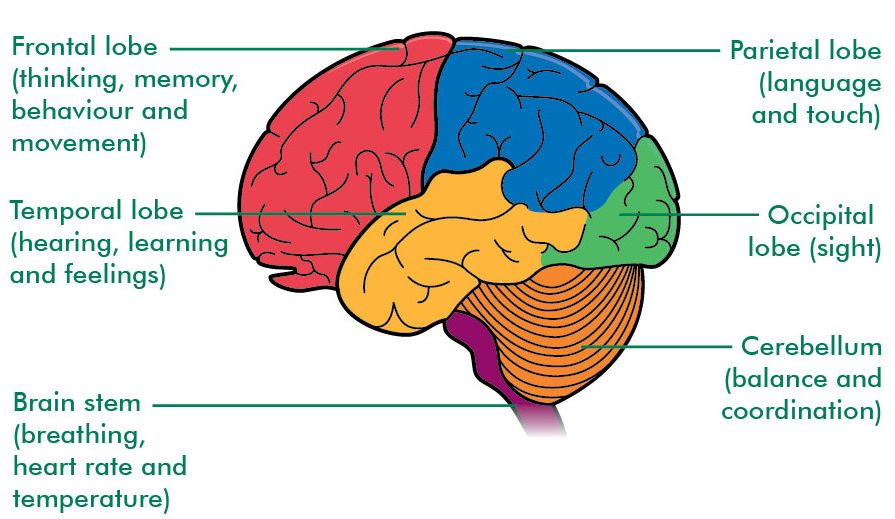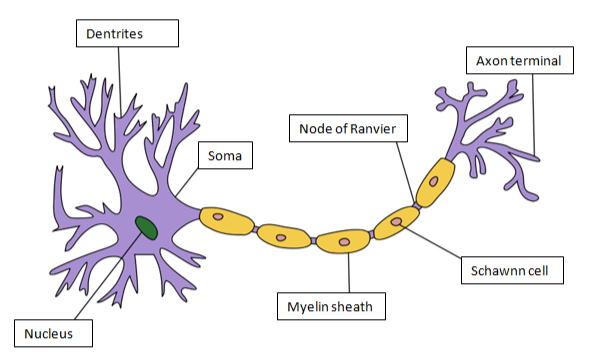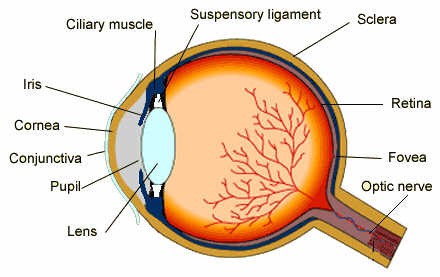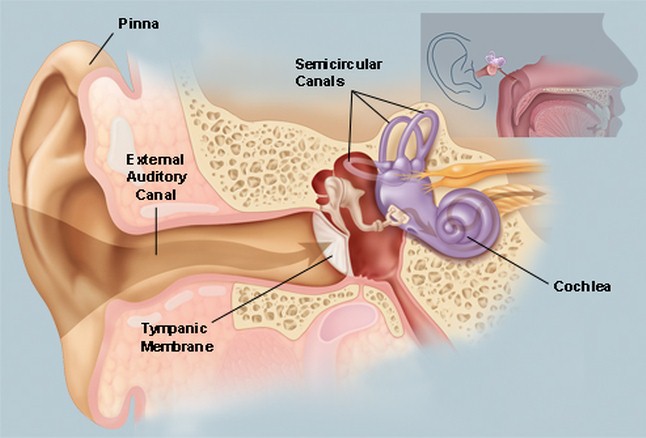.
The structures and functions of the eyes are complex. Each eye constantly adjusts the amount of light it lets in, focuses on objects near and far, and produces continuous images that are instantly transmitted to the brain.
The orbit is the bony cavity that contains the eyeball, muscles, nerves, and blood vessels, as well as the structures that produce and drain tears. Each orbit is a pear-shaped structure that is formed by several bones.
आंखों की संरचना और कार्य जटिल हैं। प्रत्येक आंख लगातार प्रकाश की मात्रा को समायोजित करती है जो इसे अंदर जाने देती है, निकट और दूर की वस्तुओं पर ध्यान केंद्रित करती है, और निरंतर छवियों का उत्पादन करती है जो तुरंत मस्तिष्क में प्रेषित होती हैं।
कक्षा हड्डी गुहा है जिसमें नेत्रगोलक, मांसपेशियां, तंत्रिकाएं और रक्त वाहिकाएं होती हैं, साथ ही साथ संरचनाएं भी होती हैं जो आँसू पैदा करती हैं और निकलती हैं। प्रत्येक कक्षा एक नाशपाती के आकार की संरचना है जो कई हड्डियों द्वारा बनाई जाती है।
Key Points
- The eye is made up of a number of parts, including the iris, pupil, cornea, and retina.
- The eye has six muscles which control the eye movement, all providing different tension and torque.
- The eye works a lot like a camera, the pupil provides the f-stop, the iris the aperture stop, the cornea resembles a lens. The way that the image is formed is much like the way a convex lens forms an image.
Key Terms
- pupil: The hole in the middle of the iris of the eye, through which light passes to be focused on the retina.
- aperture: The diameter of the aperture that restricts the width of the light path through the whole system. For a telescope, this is the diameter of the objective lens (e.g., a telescope may have a 100 cm aperture).
प्रमुख बिंदु
आंख कई हिस्सों से बनी है, जिसमें आईरिस, पुतली, कॉर्निया और रेटिना शामिल हैं।
आंख में छह मांसपेशियां होती हैं जो आंखों की गति को नियंत्रित करती हैं, सभी अलग-अलग तनाव और टॉर्क प्रदान करती हैं।
आंख एक कैमरे की तरह बहुत काम करती है, पुतली एफ-स्टॉप प्रदान करती है, आईरिस एपर्चर स्टॉप, कॉर्निया एक लेंस जैसा दिखता है। जिस तरह से छवि का निर्माण होता है, वह उस तरह से होता है, जिस तरह से उत्तल लेंस एक छवि बनाता है।
मुख्य शर्तें
पुतली: आंख के परितारिका के बीच का छेद, जिससे होकर प्रकाश रेटिना पर केंद्रित होता है।
एपर्चर: एपर्चर का व्यास जो पूरे सिस्टम के माध्यम से प्रकाश पथ की चौड़ाई को प्रतिबंधित करता है। टेलीस्कोप के लिए, यह ऑब्जेक्टिव लेंस का व्यास है (उदाहरण के लिए, टेलीस्कोप में 100 सेमी एपर्चर हो सकता है)।
The human eye is the gateway to one of our five senses. The human eye is an organ that reacts with light. It allows light perception, color vision and depth perception. A normal human eye can see about 10 million different colors! There are many parts of a human eye, and that is what we are going to cover in this atom.
Properties
Contrary to what you might think, the human eye is not a perfect sphere, but is made up of two differently shaped pieces, the cornea and the sclera. These two parts are connected by a ring called the limbus. The part of the eye that is seen is the iris, which is the colorful part of the eye. In the middle of the iris is the pupil, the black dot that changes size. The cornea covers these elements, but is transparent. The fundus is on the opposite of the pupil, but inside the eye and can not be seen without special instruments. The optic nerve is what conveys the signals of the eye to the brain. is a diagram of the eye. The human eye is made up of three coats:
- Outermost Layer – composed of the cornea and the sclera.
- Middle Layer – composed of the choroid, ciliary body and iris.
- Innermost Layer – the retina, which can be seen with an instrument called the ophthalmoscope.
Once you are inside these three layers, there is the aqueous humor (clear fluid that is contained in the anterior chamber and posterior chamber), vitreous body (clear jelly that is much bigger than the aqueous humor), and the flexible lens. All of these are connected by the pupil.
मानव आंख हमारी पांच इंद्रियों में से एक का प्रवेश द्वार है। मानव आँख एक अंग है जो प्रकाश के साथ प्रतिक्रिया करता है। यह प्रकाश धारणा, रंग दृष्टि और गहराई की धारणा की अनुमति देता है। एक सामान्य मानव आँख लगभग 10 मिलियन विभिन्न रंगों को देख सकती है! एक इंसानी आंख के कई हिस्से हैं, और यही हम इस परमाणु में शामिल होने जा रहे हैं।
गुण
आप जो सोच सकते हैं, उसके विपरीत, मानव आंख एक संपूर्ण क्षेत्र नहीं है, लेकिन दो अलग-अलग आकार के टुकड़ों, कॉर्निया और श्वेतपटल से बना है। ये दोनों भाग एक रिंग से जुड़े होते हैं जिसे लिमबस कहा जाता है। आंख का जो हिस्सा दिखाई पड़ता है वह परितारिका है, जो आंख का रंगीन हिस्सा है। परितारिका के बीच में पुतली है, काली बिंदी जो आकार बदलती है। कॉर्निया इन तत्वों को कवर करता है, लेकिन पारदर्शी है। निधि पुतली के विपरीत पर है, लेकिन आंख के अंदर और विशेष उपकरणों के बिना नहीं देखा जा सकता है। ऑप्टिक तंत्रिका वह है जो आंख के संकेतों को मस्तिष्क तक पहुंचाती है। आंख का एक आरेख है। मानव आँख तीन कोटों से बनी होती है:
बाह्य परत - कॉर्निया और श्वेतपटल से बना है।
मध्य परत - कोरॉइड, सिलिअरी बॉडी और आइरिस से बना है।
इनरमोस्ट लेयर - रेटिना, जिसे ओफ्थाल्मोस्कोप नामक उपकरण के साथ देखा जा सकता है।
एक बार जब आप इन तीन परतों के अंदर होते हैं, तो जलीय हास्य होता है (स्पष्ट तरल पदार्थ जो पूर्वकाल कक्ष और पीछे के कक्ष में निहित होता है), विट्रीस बॉडी (स्पष्ट जेली जो जलीय हास्य की तुलना में बहुत बड़ा होता है), और लचीला लेंस होता है। ये सभी पुतली द्वारा जुड़े हुए हैं।

:

Diagram of the Human Eye: The cornea and lens of an eye act together to form a real image on the light-sensing retina, which has its densest concentration of receptors in the fovea and a blind spot over the optic nerve. The power of the lens of an eye is adjustable to provide an image on the retina for varying object distances. Layers of tissues with varying indices of refraction in the lens are shown here. However, they have been omitted from other pictures for clarity.






